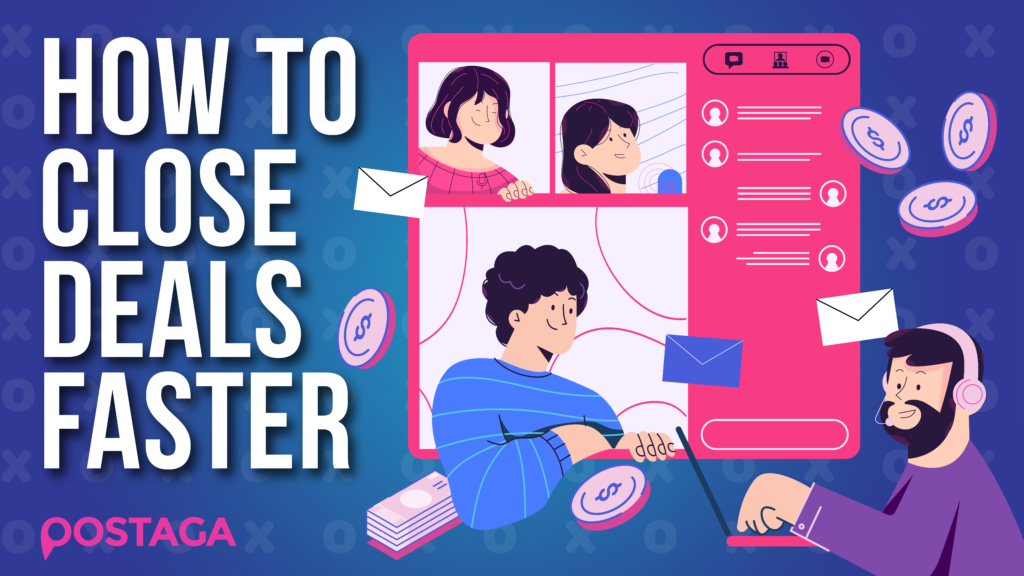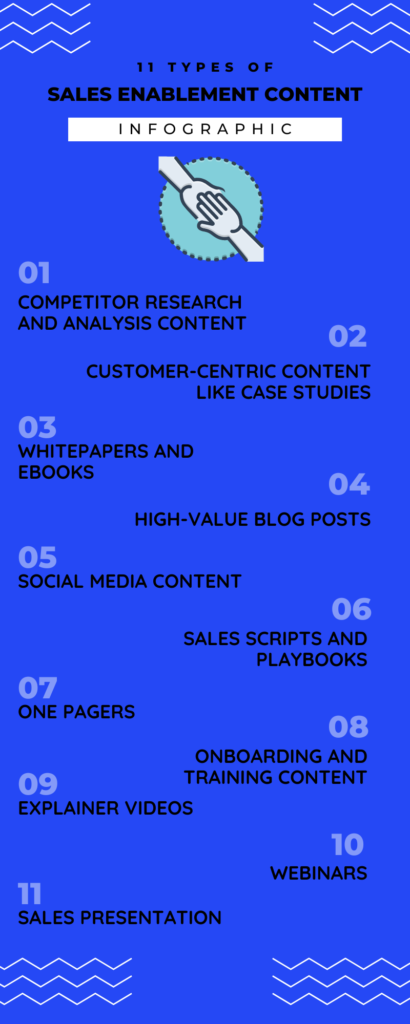
(This is a guest post from narrato.io)
The most important (and also difficult) part of every sales cycle is closing the deal. It also marks the beginning of the buyer’s journey with your business.
So, what can you do to close deals faster? This is where sales enablement content comes in.
Sales enablement content empowers your sales team to provide the buyers with in-depth information about your product, while addressing any concerns they might have. It essentially helps your sales team sell your product more effectively.
In the following sections, we’ll tell you everything about sales enablement content, from the various types of sales enablement content to the process of creating them.
Let’s get straight to it.

What makes sales enablement content different from marketing content?
The aim of marketing content is to attract top-of-the-funnel prospects (customers still in the awareness stage). Marketing content is excellent for creating awareness about your product and brand, with the goal of driving them to perform some action. Sales enablement content, on the other hand, makes the very foundation of your interaction with the customers. It guides your sales team’s conversations with the customers throughout their customer journey.
While marketing content helps in setting the narrative, you need sales enablement content to position your brand the right way in the eyes of your customers. Sales enablement content is the perfect ammunition for your sales team for engaging potential customers, converting them, and ultimately closing deals.
Why use Sales Enablement Content?
- What’s the point of sales enablement content?
- Wouldn’t my efforts be better utilized in product improvement or other aspects of my business?
- Why should I focus so much of my time and energy on creating sales enablement content?
If these are some questions going through your mind, here’s an interesting fact for you –
In a recent HubSpot survey, it was found that sales enablement content helped almost 65% of sales professionals in outperforming their revenue targets.
To ensure greater conversions for your business, you need to understand how the buyer operates. Most buyers prefer to research a product and examine all the alternatives before making a purchase decision. Thereafter, they reach out to the sales team to better understand the product and get answers to any important queries they might have. Sales enablement content allows your sales team to develop strategies for educating the buyers and answering their queries. It will help the team learn where the buyer is in their customer journey, so that they can pitch the product more appropriately.
Here’s how you can benefit from creating sales enablement content –
1. Help your sales teams realize their targets and goals.
2. Facilitate onboarding and training of new salespersons.
3. To address any inefficiencies in the sales strategies used by your sales team.
4. Helps ensure better collaboration and coordination between your marketing, product development, and sales departments
5. Ensure that your sales team has a solid understanding of the various benefits and capabilities of your product.
So, now you know why sales enablement content can be the key to gaining a competitive advantage in your industry. With this in mind, let’s discuss the different types of sales enablement content you can create.

Types of Sales Enablement Content
1. Competitor Research and Analysis Content
You can create a comprehensive document containing in-depth competitor research and analysis, which can then be provided to your sales team. Competitor research can actually provide your sales team with a wealth of insights into the needs of your target audience. With this document, your sales team will be in a better position to persuade a prospect to close the deal.
2. Customer-Centric Content like Case Studies
Customer-centric content lays out the details of the needs, wants, and preferences of the customers. You can think of creating something like a Case Study, which explains how other users have benefited from using your product. Your sales team can then use this case study to build the prospect’s trust in your business and product.
3. Whitepapers and eBooks
Often used in content marketing, whitepapers and eBooks can be invaluable for sales professionals too. Whitepapers and eBooks contain educational information and other relevant data about your product. They can be used as handy reference material for sales professionals when they need to make a last-minute pitch.
4. High-Value Blog Posts
Your marketing team is already creating blog posts as part of your overall content marketing strategy. You can direct them to create more high-value blog posts focusing on specific features of your product. These blog posts should also contain tips and benefits on using these features. During sales calls, your sales team can direct the prospects to these blog posts to provide them with a better understanding of the product and its use cases.
5. Social Media Content
Your social media channel can be great for engaging your prospects. Your marketing team might already be taking care of your business’s social media presence by creating high-quality content for it consistently. When required, your sales team can also send out the links to the high-performing social media content to the prospects. You can use social media analytics tools to measure the success of your social media posts.
6. Sales Scripts and Playbooks
Sales scripts can be great for guiding the conversations your sales professionals have with your potential customers. It’s important to keep in mind that sales scripts are not line-by-line descriptions of the conversation, but an outline containing all major talking points. You can also create a sales playbook, which will essentially contain information about all your sales processes and strategies.

7. One Pagers
This one-page document will contain all the important facts about your brand and your product/service. One pagers can be a great resource for your sales team in times of need, especially if you sell multiple products. A good one pager should consist of –
- What your product does.
- Cost of the product.
- Who is it for.
- Benefits and USPs
8. Onboarding and training content
This type of content is especially useful for training new sales professionals and providing them with relevant information about the business and product. Besides this, onboarding and sales trainings can also educate them on the voice and tone they need to use while interacting with the customer.
9. Explainer videos
Use your case studies and whitepapers to create explainer videos of your product and its features. Explainer videos can be great sales enablement content for supporting your sales team at all the steps in the buyer journey.
10. Webinars
Your sales team can also direct your prospects to product-led webinars. Host these webinars with your product managers to explain to the prospective buyers the various ways in which your product can be beneficial for them. After the webinar, you can hold a Q&A session with the audience.
11. Sales Presentation
A well-designed sales presentation can be very helpful in setting the tone of your conversations with potential customers. Not only will it help in leaving a good impression on the prospects, but it will also distinguish you from your competitors.
Where to source sales enablement content from?
Here are some other tips on sourcing material for your sales enablement content –
1. Conversations with Customers – for creating video stories, sales scripts, onboarding content, product feature walk-throughs
A lot of the objections and questions raised by customers during an actual sales call can be used to create sales enablement content. It’s all about capturing important bits from customer conversations that repurposing them into useful insights to guide your sales team.
2. Feedback from Existing Customers – for creating competitor research and analysis content and case studies
Most customers decide on a product after conducting thorough research. This means that they have already evaluated the pros and cons of different products in the same niche, and found your product to best meet their needs. You can ask for some feedback from your existing customers to understand why they chose your product. What was it about your product that stood out for them?
3. Product Documentation – for creating product specification documents, one-pagers, product comparison charts
Your product-related documents contain some great material for creating bottom-of-the-funnel content. Since the product documentation can’t be shared with the customers, your marketing and product development teams can help in repurposing them for prospects. This content can be great for solving any technical queries.
4. Marketing Content – for creating high-value blog posts, eBooks, and whitepapers
Even though the goal of marketing content is different, it can still be used for sales enablement (with certain modifications). Go through your marketing content to identify which ones best fit your needs. When repurposing marketing content like a blog post into a sales asset, remember to convert it into a pdf file so that it appears more like a sales asset
5. Insights from customer success teams – for creating product specifications, written testimonials, case studies
Your customer success team can provide you with useful insights from their interactions with the customers. They know what worked well for your customers, which can be used to build useful sales enablement content for last-stage prospects.
6. Internal Knowledge Base – for creating competitor research and analysis content, company profile, buyer personas
This is a no-brainer. Your company knowledge base which comes with all the information about your products, policies, vision, and more can be a useful resource for building sales enablement content.
How to create sales enablement content?

To create sales enablement content, you need to understand the individual steps that go into the process.
Step 1: Go through the existing content
The first thing you need to do is review all the existing content your sales team is using. In this step, it’s all about identifying any gaps in your content. Try to understand which type of sales enablement content is working for your business, and which ones are not. You can ask your sales team which type of content helps them the most in closing deals.
Step 2: Brainstorm strategy for creating sales enablement content
After you’ve identified the gaps in your content, it’s time to come up with a sales enablement content strategy. In this step, you can get your marketing, product development, and sales team together to ideate and brainstorm the content strategy. Since each team will bring their own views and insights to the discussion, you’ll be able to come up with some great ideas for creating valuable sales enablement content for –
- Top-of-the-funnel prospects
- Middle-of-funnel prospects
- Bottom-of-funnel prospects.
Step 3: Use internal knowledge to create sales enablement content
Once you have a sales enablement content strategy in place, you can get down to creating the content. Collate the information from your internal knowledge base to add to the sales enablement content. You can also collect inputs from the product experts for the purpose.
It’s a good idea to create a content creation workflow at this stage so that every team member knows what needs to be done. This helps in bringing greater transparency and accountability into the sales enablement content creation process.
Step 4: Get tools to help you
Some useful tools that will help you create sales enablement content are –
1. Narrato – Content Workflow Management Platform
This content workflow platform comes with a powerful AI Writing tool and a range of other capabilities to help you create high-quality sales enablement content. While the AI writer can generate content for a variety of use cases, the AI content assistant can give you suggestions for improving the sales enablement content’s readability and grammar. Other features include –
- Custom user roles: Control your content projects better after adding different members from different teams (sales, marketing, product development) to the project. Set user roles like admin, project manager, editor, content creator, and client, along with custom access.
- Custom workflows: Set custom workflows (task-based or status-based) to gain more visibility into the status of each content task.
- SEO Content Brief: The SEO brief generator can automatically generate content briefs based on your input. It can provide you suggestions for keywords, topics, questions to include, references, and more. A content brief can be very useful for streamlining the content workflow and keeping everyone on track with the goals of the content project.
- Content calendar: This is useful for planning your sales enablement content in advance, and keeping a track of the types of content you’ve already created.
2. Postaga – Link Building Outreach Platform
This is an excellent outreach tool for building backlinks to your blog posts. It can analyze your content for outreach opportunities, find contacts, verify their email addresses, and send them outreach email sequences. Postaga can be very useful for saving the time and effort that usually goes into building outreach campaigns for link building. So how will it help your sales enablement content? Link building will help you increase the authority of your blog post, which can be used as sales enablement content too. So if you want high-value and high-authority blog posts for your sales enablement content, Postaga is the tool for you.
3. Qualaroo – Customer Survey Tool
This tool can help you conduct customer surveys to understand which content types would be most appropriate for sales enablement. Using this, you can gain a better understanding of your customers’ pain points and how your product addresses them.
Step 5: Align content with customer’s journey
In the last step, you have to ensure that each sales enablement content you’ve created is aligned with the buyer journey. It’s important that the content helps your sales team engage the prospects at every point in their customer journey. It should help them in answering any initial queries, and also facilitate the final deal closing.

Final Thoughts
With this, we’ve covered everything there is to know about creating sales enablement content. When your marketing, sales, customer success, and product development teams are able to come together to create excellent sales enablement content, you’ll be able to –
- Move leads further down the sales funnel
- Drive more conversions
- Provide more value to your prospective customers
If you still haven’t created your sales enablement content, this is your cue to start strategizing for one today!
Free 14-Day Trial
Start building relationships now with your fully-featured 14-day trial!
How We Compare
Terms | Done-For-You Terms | Privacy | Write For Us | Press
© 2025 Postaga. All Rights Reserved. Made with 
